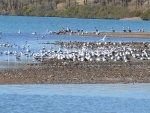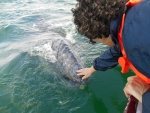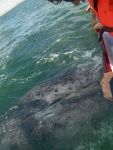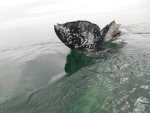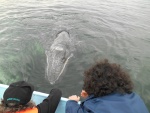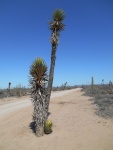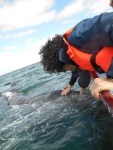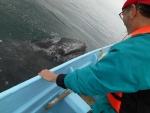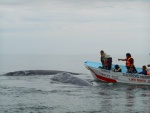Ojo de Liebre, Loreto, and CDMX
For years we had thought about a trip to see gray whales calving in Baja California, and in February 2014 we made it happen. After a lot of research, we decided to visit a specific bay, Ojo de Liebre (Eye of the Hare) where the whales come each winter to calve and feed in the warm waters. Our friends Joel and Wendy joined us. We stayed at a small motel near the Bay and found a local guide who took us to the Bay, helped us hire a boat, and have the adventure of a lifetime.

Ojo de Liebre is a lagoon on the west coast of Mexico’s Baja peninsula. It’s about halfway between Tijuana and Cabo San Lucas. We flew into Loreto on Baja’s east coast, rented a car and drove across the peninsula to Guerrero Negro, the nearest town to the lagoon. The scenery along the way was dramatic, with rugged mountains and saguaro cactus.
Ojo de Liebre is the largest Gray Whale calving lagoon in the world, and usually has over 1,500 whales in mid-season. Gray Whales are the most commonly seen whales along the California and Mexican coast. The lagoon is the whale’s nursery, where the mothers bear and raise their calves while the males guard the lagoon’s only inlet. A calf is about 17 feet long at birth, quickly growing while in the lagoon before it leaves along its migration route north.

In our trip, we experienced a wide variety of whale behavior: breaching, feeding, and playing – with each other and with us! The whales were curious and friendly. The newborn calves swam over to our boat while the mothers watched nearby. They passed under the boat, gently brushing the hull, perhaps letting us know that this could end very badly if we don’t behave. The calves behaved like curious puppies, coming alongside and surfacing to let us pet them. The seemed to deeply enjoy visiting us – before going on to another boat to get more attention.
Only a limited number of wooden boats are allowed into the lagoon when the whales are calving. As we set out on the first day, it looked like there were many small islands in the distance – but we quickly learned that these were female whales and calves in pairs, dotted around in the distance. The boats are not allowed to approach the whales, but the boat owners know to tap on the sides of their boats and the whales, curious and friendly, came to us! It was an amazing experience to have these giant creatures lift their heads out of the water to be patted. At one point, a baby whale boosted itself up on its mother’s back and rested its chin on the edge of the boat so that we could shower it with rubs, pats and, yes, even kisses.
After two amazing days of visiting the whales we drove across Baja to Loreto, and spent time birdwatching, seeking authentic Mexican food, and enjoying the warm weather. During the day, we visited the beaches and took a great ride to visit dolphins, who jumped over and around the small boat endlessly.
After Loreto, we left our friends and went on to spend a few days in Mexico City
Logistics:
Access to Ojo de Liebre is via Scammon’s Lagoon, located just outside Guerro Negro. To avoid the commercial “gringo” tours, take a taxi out to the lagoon. You’ll see a small building that arranges excursions with individual “ponga” boatmen. Commercial tours are not allowed in the lagoon with the mothers and babies, but the pongas are. Scammon’s Lagoon is the most protected area for whales; the strictest regulations are in effect there.
In Loreto, we stayed at Hotel Los Caracoles, which offered basic accommodations and friendly staff. There are a lot of upscale places in Guerrero Negro that cater to gringos.
There are very few flights to Loreto. We flew via LAX on Alaska Air, and at that time were also flights on some smaller Mexican airlines. The fact that Ojo de Liebre is so difficult to get to and far from everything helps protect the whales. Hopefully it will remain that way.

